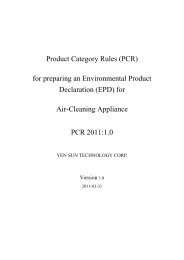Download(PDF) - PCR Library
Download(PDF) - PCR Library
Download(PDF) - PCR Library
You also want an ePaper? Increase the reach of your titles
YUMPU automatically turns print PDFs into web optimized ePapers that Google loves.
PRODUCT CATEGORY RULES<br />
DATE 2012-08-23<br />
UN CPC 013<br />
FRUITS AND NUTS<br />
GENERAL INTRODUCTION<br />
The International EPD ® System is based on a hierarchic approach following the international standards:<br />
ISO 9001, Quality management systems<br />
ISO 14001, Environmental management systems<br />
ISO 14040, LCA - Principles and procedures<br />
ISO 14044, LCA - Requirements and guidelines<br />
ISO 14025, Type III environmental declarations<br />
ISO 21930, Environmental declaration of building products<br />
The General programme Instructions are based on these standards, as well as instructions for developing Product<br />
Category Rules (<strong>PCR</strong>).<br />
The documentation to The International EPD ® System includes three separate parts (www.environdec.com ):<br />
Introduction, intended uses and key programme elements<br />
General Programme Instructions Supporting annexes<br />
Supporting annexes<br />
This <strong>PCR</strong> document specifies further and adds additional minimum requirements on EPDs of the product group<br />
defined below complementary to the above mentioned general requirement documents. Principle programme<br />
elements concerning the Product Category Rules (<strong>PCR</strong>) included in The International EPD ® System are presented<br />
below.<br />
PURPOSE ELEMENT IDENTIFICATION AND PRINCIPAL APPROACH<br />
Complying with principles set in ISO 14025<br />
on modularity and comparability<br />
Simplifying work to develop Product<br />
Category Rules (<strong>PCR</strong>)<br />
Secure international participation in <strong>PCR</strong><br />
work<br />
Facilitating, identification and collection of<br />
LCA-based information<br />
1. "Book-keeping LCA approach"<br />
2. A Polluter-Pays (PP), allocation method<br />
3. <strong>PCR</strong> Module Initiative (PMI) in order to structure <strong>PCR</strong> in modules<br />
according to international classification<br />
4. <strong>PCR</strong> moderator for leadership and support of the <strong>PCR</strong> work<br />
5. Global <strong>PCR</strong> Forum for open and transparent EPD stakeholder<br />
consultation<br />
6. Selective data quality approach for specific and generic data<br />
Product Category Rules (<strong>PCR</strong>) are specified for specified information modules “gate-to-gate”, so called core modules.<br />
The structure and aggregation level of the core modules are defined by the United Nation Statistics Division -<br />
Classification Registry CPC codes (http://unstats.un.org). The <strong>PCR</strong> also provides rules for which methodology and<br />
data to use in the full LCA, i.e. life cycle parts up-streams and down-streams the core module.<br />
The <strong>PCR</strong> also has requirements on the information given in the EPD, e.g. additional environmental information. A<br />
general requirement on the information in the EPD is that all information given in the EPD, mandatory and voluntary,<br />
shall be verifiable.<br />
In the EPD, the environmental performance associated with each of the three life-cycle stages mentioned above are<br />
reported separately.<br />
Cover: ©iStockphoto.com/Tarek El Sombati<br />
PAGE 2/18















